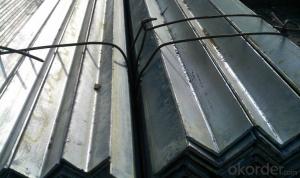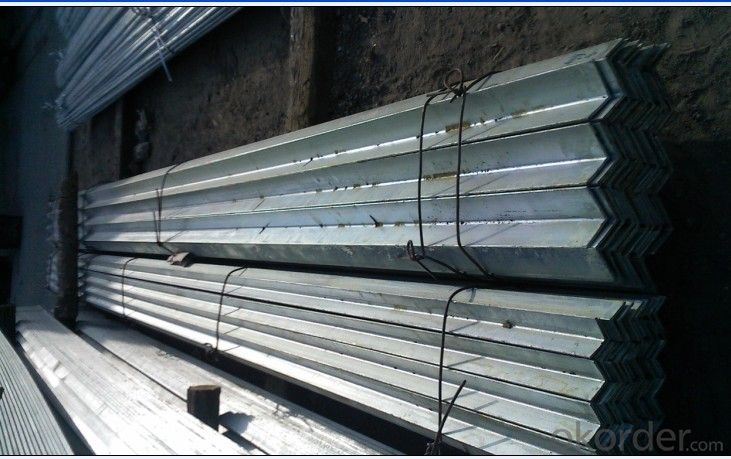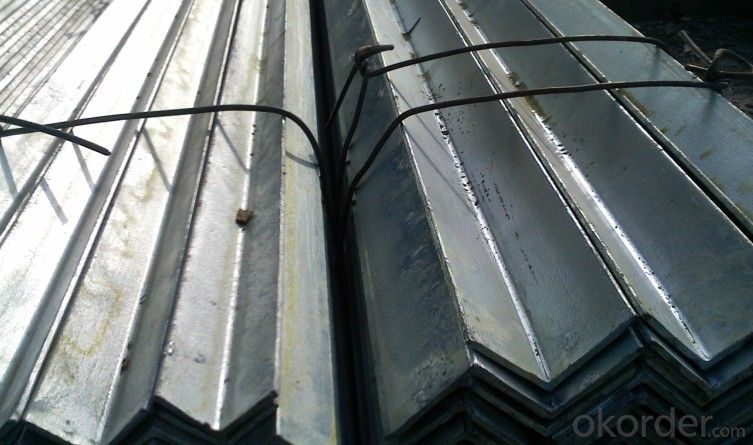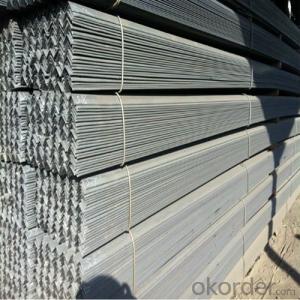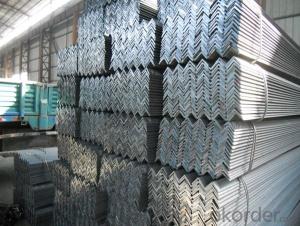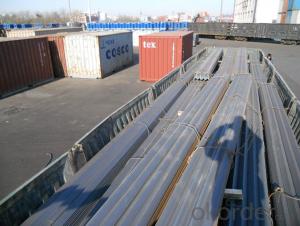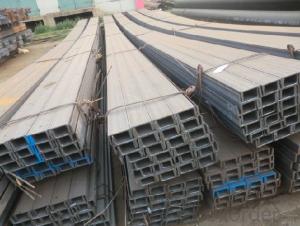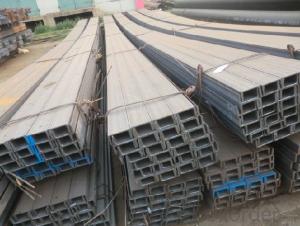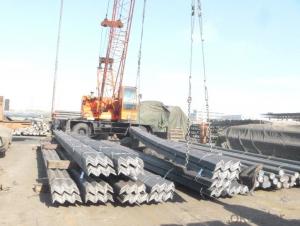hot angleand gb
- Loading Port:
- China Main Port
- Payment Terms:
- TT OR LC
- Min Order Qty:
- -
- Supply Capability:
- -
OKorder Service Pledge
OKorder Financial Service
You Might Also Like
Product Description:
Specifications of Angle Steel
1. Invoicing on theoretical weight or actual weight as customer request
2. Length: 6m, 9m, 12m as following table
3. Sizes

Sizes: 25mm-250mm | ||
a*t | ||
25*2.5-4.0 | 70*6.0-9.0 | 130*9.0-15 |
30*2.5-6.6 | 75*6.0-9.0 | 140*10-14 |
36*3.0-5.0 | 80*5.0-10 | 150*10-20 |
38*2.3-6.0 | 90*7.0-10 | 160*10-16 |
40*3.0-5.0 | 100*6.0-12 | 175*12-15 |
45*4.0-6.0 | 110*8.0-10 | 180*12-18 |
50*4.0-6.0 | 120*6.0-15 | 200*14-25 |
60*4.0-8.0 | 125*8.0-14 | 250*25 |
5. Payment terms:
1).100% irrevocable L/C at sight.
2).30% T/T prepaid and the balance against the copy of B/L.
3).30% T/T prepaid and the balance against L/C
6.Material details:
Alloy No | Grade | Element (%) | | ||||
C | Mn | S | P | Si | | ||
| | |||||||
|
|
|
|
|
|
| |
Q235 | B | 0.12—0.20 | 0.3—0.7 | ≤0.045 | ≤0.045 | ≤0.3 | |
|
|
|
|
|
|
| |
Alloy No | Grade | Yielding strength point( Mpa) | | ||||
Thickness (mm) | | ||||||
≤16 | >16--40 | >40--60 | >60--100 | | |||
≥ | | ||||||
|
|
|
|
|
| | |
Q235 | B | 235 | 225 | 215 | 205 | | |
Alloy No | Grade | Tensile strength (Mpa) | Elongation after fracture (%) | | |||
Thickness (mm) | | ||||||
| ≤16 | >16--40 | >40--60 | >60--100 | | ||
≥ | | ||||||
|
|
|
|
|
|
| |
Q235 | B | 375--500 | 26 | 25 | 24 | 23 | |
Usage & Applications of Angle Steel
According to the needs of different structures, Angle can compose to different force support component, and also can be the connections between components. It is widely used in various building structures and engineering structures such as roof beams, bridges, transmission towers, hoisting machinery and transport machinery, ships, industrial furnaces, reaction tower, container frame and warehouse etc.
Packaging & Delivery of Angle Steel
1. Packing: it is nude packed in bundles by steel wire rod
2. Bundle weight: not more than 3.5MT for bulk vessel; less than 3 MT for container load
3. Marks:
Color marking: There will be color marking on both end of the bundle for the cargo delivered by bulk vessel. That makes it easily to distinguish at the destination port.
Tag mark: there will be tag mark tied up on the bundles. The information usually including supplier logo and name, product name, made in China, shipping marks and other information request by the customer.
- Q: Can steel angles be used in outdoor or corrosive environments?
- Yes, steel angles can be used in outdoor or corrosive environments. Steel angles are often made from low carbon steel or stainless steel, both of which have excellent corrosion resistance properties. Additionally, steel angles can be further protected from corrosion by applying coatings such as galvanization or painting. These protective coatings create a barrier between the steel and the corrosive elements in the environment, preventing rust and degradation. Therefore, steel angles are commonly used in outdoor structures, such as bridges, buildings, and industrial facilities, where they are exposed to moisture, saltwater, or other corrosive elements.
- Q: Can steel angles be used in electrical applications?
- Steel angles have a wide range of applications in the electrical industry. They are commonly used as structural supports in various industries, including electrical installations. These angles offer stability and strength to electrical setups, especially when used for mounting equipment like junction boxes, panels, or conduits. One of the key advantages of steel angles is their durability and excellent load-bearing capacity. This makes them suitable for supporting heavy electrical components. Additionally, they are corrosion-resistant, which is particularly important in electrical applications where moisture or environmental factors may be present. Furthermore, steel angles can be easily customized and fabricated to meet specific requirements. They can be cut, drilled, welded, or shaped into various forms to accommodate different electrical configurations. This flexibility allows for easy installation and ensures compatibility with other electrical components. To summarize, steel angles are a reliable choice for electrical applications due to their strength, durability, corrosion resistance, and versatility. They provide crucial support and stability to electrical installations, making them the preferred option for a variety of electrical projects.
- Q: Can steel angles be used for modular furniture or fixtures?
- Yes, steel angles can be used for modular furniture or fixtures. Steel angles are versatile and durable, making them suitable for various applications in modular furniture design. They provide structural support and can be used as framing elements or brackets for assembling different modular components. Additionally, steel angles offer excellent strength and stability, ensuring the stability and longevity of modular furniture and fixtures.
- Q: Can steel angles be used for bracing purposes?
- Yes, steel angles can be used for bracing purposes. Steel angles have excellent strength and rigidity, making them suitable for providing additional support and stability in various structural applications. They are commonly used in construction, engineering, and industrial projects for bracing purposes to reinforce and stabilize structures against lateral forces, such as wind or seismic loads.
- Q: What are the different types of steel angles used in automotive manufacturing?
- In automotive manufacturing, there are several types of steel angles that are commonly used. These steel angles are crucial components in the construction and design of various automotive structures and parts. Some of the different types of steel angles used in automotive manufacturing include: 1. Equal Angle: This type of steel angle has equal length sides that form a 90-degree angle. Equal angles are typically used in automotive manufacturing for structural applications, such as chassis frames, brackets, and suspension components. 2. Unequal Angle: As the name suggests, unequal angles have unequal length sides that form a 90-degree angle. These angles are commonly used in automotive manufacturing to create components with specific dimensions and angles, such as door frames, body reinforcements, and support structures. 3. L Angle: L angles, also known as angle irons, have two equal length sides that form a 90-degree angle. They are widely used in automotive manufacturing for various purposes, including reinforcing panels, mounting brackets, and structural supports. 4. T Angle: T angles have one long side and one short side that form a 90-degree angle, resembling the letter "T." They are commonly utilized in automotive manufacturing for joining different components, such as body panels, fenders, and roof structures. 5. C Angle: C angles, also called channel angles, have a C-shaped cross-section. They are extensively used in automotive manufacturing for applications requiring structural strength and rigidity, such as frame rails, roll cages, and support beams. 6. Z Angle: Z angles have a Z-shaped cross-section, resembling the letter "Z." They are commonly employed in automotive manufacturing for joining and reinforcing various components, such as door frames, roof structures, and body reinforcements. These are just a few examples of the different types of steel angles used in automotive manufacturing. Each type serves a specific purpose and offers unique properties, such as strength, stability, and flexibility, to meet the requirements of different automotive applications.
- Q: Can steel angles be used in pedestrian bridges?
- Yes, steel angles can be used in pedestrian bridges. Steel angles provide structural support, stability, and durability to the bridge, making them a commonly used material in bridge construction.
- Q: Can steel angles be used for platform structures?
- Yes, steel angles can be used for platform structures. Steel angles are commonly used in construction for their strength, durability, and versatility. They provide structural support and stability to various types of platforms, including elevated walkways, mezzanines, catwalks, and scaffolding. Steel angles offer excellent load-bearing capacity and can withstand heavy loads, making them suitable for platform structures that require a high level of strength and stability. Additionally, steel angles can be easily fabricated and joined together, allowing for efficient construction and customization of platform structures.
- Q: What are the common defects or issues found in steel angles?
- Some common defects or issues found in steel angles include surface imperfections such as cracks, scratches, or dents, dimensional variations such as uneven or inconsistent lengths, widths, or thicknesses, and improper alignment or straightness. Other issues can include corrosion, rusting, or lack of proper coating, as well as inadequate welding or joining, leading to weak or compromised structural integrity.
- Q: Can steel angles be used for bracing?
- Certainly! Bracing can be achieved using steel angles. These angles are widely employed in construction and engineering ventures to furnish structural support and reinforcement. Their versatility allows for effortless welding or bolting, rendering them adaptable to diverse applications, including bracing. Owing to their inherent strength and rigidity, steel angles excel at bestowing stability and withstanding lateral forces. They are frequently utilized to brace columns, beams, and other structural components, thereby augmenting the overall robustness and stability of the edifice.
- Q: What is the process of cold bending steel angles?
- The process of cold bending steel angles involves manipulating the angles into a desired shape without the use of heat. This is done by applying force or pressure to the angles in a controlled manner. First, the steel angle is secured in a bending machine or fixture that can hold it securely in place during the bending process. The operator then determines the desired angle and bend radius, which determines the amount of force that needs to be applied. Next, the bending machine or fixture applies pressure to the steel angle, gradually bending it to the desired shape. The force is typically applied slowly and evenly to prevent any deformation or damage to the steel. During the bending process, it is important to monitor the angle and ensure that it is bending evenly and smoothly. The operator may need to make adjustments to the pressure or angle of the bending machine to achieve the desired shape. Once the steel angle has been bent to the desired angle, it is carefully removed from the bending machine or fixture. It is important to handle the bent angle with care to prevent any distortion or damage. Cold bending steel angles offers several advantages over hot bending, such as reduced risk of material distortion or weakening due to heat. It also allows for more precise and controlled bending, making it suitable for a wide range of applications where accuracy is crucial. Overall, the process of cold bending steel angles involves securely positioning the angle in a bending machine or fixture, applying gradual and controlled pressure to bend it to the desired shape, and carefully removing the bent angle for further use.
Send your message to us
hot angleand gb
- Loading Port:
- China Main Port
- Payment Terms:
- TT OR LC
- Min Order Qty:
- -
- Supply Capability:
- -
OKorder Service Pledge
OKorder Financial Service
Similar products
Hot products
Hot Searches
Related keywords
